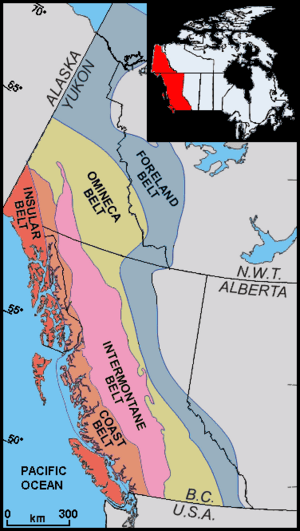Omineca Arc facts for kids
The Omineca Arc (also called the Omineca Belt) was a long chain of volcanoes that existed millions of years ago. It was a special type of land called a terrane, which is a piece of Earth's crust that formed somewhere else and then joined a larger continent. The Omineca Arc was active during the Jurassic and Cretaceous periods, which means it existed from about 201 to 66 million years ago.
Contents
What Was the Omineca Arc?
The Omineca Arc was like a giant string of volcanoes. It stretched across western North America. This included areas that are now Alaska, Yukon, British Columbia, and Washington.
Where Was the Omineca Arc Located?
This ancient volcanic chain was found between two other large land areas. To its east was the Foreland Belt. To its west was the Intermontane Belt. The Omineca Arc gets its name from the Omineca Mountains. These mountains are in the northern part of British Columbia.
How Did the Omineca Arc Form?
Volcanic arcs like the Omineca Arc usually form when two of Earth's giant plates collide. One plate slides under the other in a process called subduction. This causes rock to melt deep underground. The melted rock then rises to the surface, creating volcanoes. The Omineca Arc was a result of these powerful geological forces.
Why Is the Omineca Arc Important?
Studying the Omineca Arc helps scientists understand how North America grew over millions of years. It shows how different pieces of land, or terranes, came together. This ancient volcanic activity shaped the landscape we see today in western Canada and the United States.


